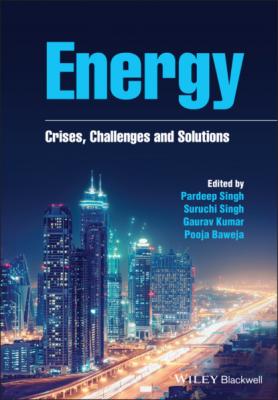Energy. Группа авторов
Читать онлайн.| Название | Energy |
|---|---|
| Автор произведения | Группа авторов |
| Жанр | Физика |
| Серия | |
| Издательство | Физика |
| Год выпуска | 0 |
| isbn | 9781119741558 |
We are highly delighted and express our gratitude to all the authors for their outstanding cooperation towards the compilation of this book. We also extend our sincere thanks to all the reviewers for their valuable suggestions and comments, which have helped us tremendously prepare this book. We also thank Wiley Publication, Andrew, Rosie, and Shiji for their generous support and efforts.
Editors
Pardeep Singh, Suruchi Singh, Gaurav Kumar, and Pooja Baweja
List of Contributors
Ambika Department of Chemistry Hansraj College University of Delhi New Delhi, India
Shachi Agrawal Department of Botany Gargi College University of Delhi New Delhi, India
Md Faiz Ahmad School of Management Malla Reddy University Hyderabad, Telangana, India
Nagendra Kumar Chandrawanshi School of Studies in Biotechnology Pt. Ravishankar Shukla University Raipur (C.G.) Raipur, Chhattisgarh, India
Md Rashid Farooqi Department of Commerce and Management Maulana Azad National Urdu University Hyderabad, Telangana, India
S.K. Jadhav School of Studies in Biotechnology Pt. Ravishankar Shukla University Raipur (C.G.) Raipur, Chhattisgarh, India
Deepali Koreti School of Studies in Biotechnology Pt. Ravishankar Shukla University Raipur (C.G.) Raipur, Chhattisgarh, India
Anjali Kosre School of Studies in Biotechnology Pt. Ravishankar Shukla University Raipur (C.G.) Raipur, Chhattisgarh, India
Shriram Kunjam Department of Botany Govt. V. Y. T. Autonomous P.G. College Durg (C.G.) Durg, Chhattisgarh, India
Pramod Kumar Mahish Department of Biotechnology Govt. Digvijay Autonomous P.G. College Rajnandgaon (C.G.) Rajnandgaon, Chhattisgarh, India
Prem Lata Meena Department of Polymer Science Bhaskaracharya College of Applied Sciences University of Delhi Dwarka, New Delhi, India
Shikha Menani Department of Commerce PGDAV College University of Delhi New Delhi, India
Anita Narang Department of Botany Acharya Narendra Dev College University of Delhi New Delhi, India
Aparna Nautiyal Department of Botany Deshbandhu College University of Delhi New Delhi, India;i‐4 Centre Deshbandhu College University of Delhi New Delhi, India
Akhlaqur Rahman District Institute of Education and Training Bihar Education Service Patna, Bihar, India
Ayyagari Ramlal Division of Genetics ICAR – Indian Agricultural Research Institute (IARI) Pusa, New Delhi, India
Sumit Sahni Department of Botany Acharya Narendra Dev College University of Delhi New Delhi, India
Anirudh Sehrawat University School of Environment Management Guru Gobind Singh Indraprastha University Dwarka, New Delhi, India
Pooja Sharma Daulat Ram College University of Delhi New Delhi, India
Sandeepa Singh Department of Botany Maitreyi College University of Delhi New Delhi, India
Manoj Kumar Singh Department of Botany Acharya Narendra Dev College University of Delhi New Delhi, India
Pradeep Pratap Singh Department of Chemistry Swami Shraddhanand College University of Delhi New Delhi, India
Renu Soni Department of Botany Gargi College University of Delhi New Delhi, India
Supriya Disaster Management Professional Sitamarhi, Bihar, India
Sudakshina Tiwari School of Studies in Biotechnology Pt. Ravishankar Shukla University Raipur (C.G.) Raipur, Chhattisgarh, India
Jyoti Tyagi Department of Chemistry Zakir Husain Delhi College University of Delhi New Delhi, India
Maya Verma Department of Physics Hansraj College University of Delhi New Delhi, India
Vinay University School of Environment Management Guru Gobind Singh Indraprastha University Dwarka, New Delhi, India
Kiran Yadav Department of Commerce PGDAV College University of Delhi New Delhi, India
1 Energy Crisis and Climate Change: Global Concerns and Their Solutions
Sandeepa Singh
Department of Botany, Maitreyi College, University of Delhi, New Delhi, India
1.1 Introduction
The energy system needs substantial decarbonization to combat climate change (Fawzy et al. 2020). However, climate change itself is often affected by energy system components that include long‐term variations in climate parameters, instability and extreme weather situations (Field et al. 2014). Energy security and climate change are also genuine global issues, which also surface worldwide public policy debates. Significant international attempts to examine climate change policies have been undertaken in the past, in order to make them more conducive to the cause (Helm and Hepburn 2009; Giddens 2011; Held et al. 2011). In this ever‐changing research area, it is vital to review literature that quantifies impacts and evaluates how this information is used to develop energy systems models.
Multiple‐source energy use has always been a primary factor in human survival and civilizational growth. When comparing our ancestors’ energy consumption quantity and trend with modern society, significant changes can be observed. Hunter‐gatherer men’s daily energy needs were about 2500 kcal before the arrival of modern agricultural techniques to sustain their nutrition, storage and reproduction, while modern man’s requirements may exceed more than 100 times their ancestors, depending on their carbon footprint (Dias 2006; WWF 2006). As his key energy source for around 500,000 years, the prehistoric man primarily used food and fire from dry biomass burning. Besides providing heat, light and fuel for cooking, fire became the main defence and cold protection device. Subsequently, people started to spend their resources on land production, and energy use became more complex so that long farming cycles dominated short hunting and gathering times. Hence, a significant advance towards civilization and urban formation was the age of energy that started with fire and firewood and extended into food energy production developments. Both fire and wood were renewable biomass sources during this time.
Moreover, at the beginning of the seventeenth and eighteenth centuries, the invention of steam engines by James Watt allowed the industrial revolution to flourish by using non‐renewable energy resources, especially ‘fossil fuels’, which included natural gas, oil and coal. Fossil fuels have been the key drivers of twenty‐first‐century economic growth from an energy perspective. However, the heavy use of fossil fuels has created some severe environmental issues since the start of the industrial revolution, including
